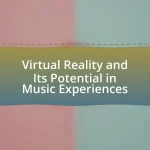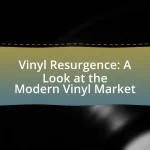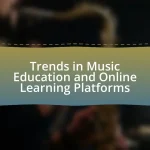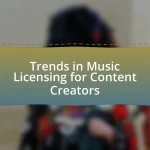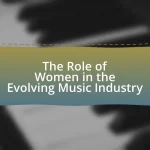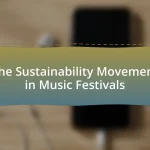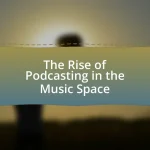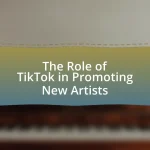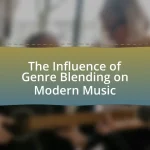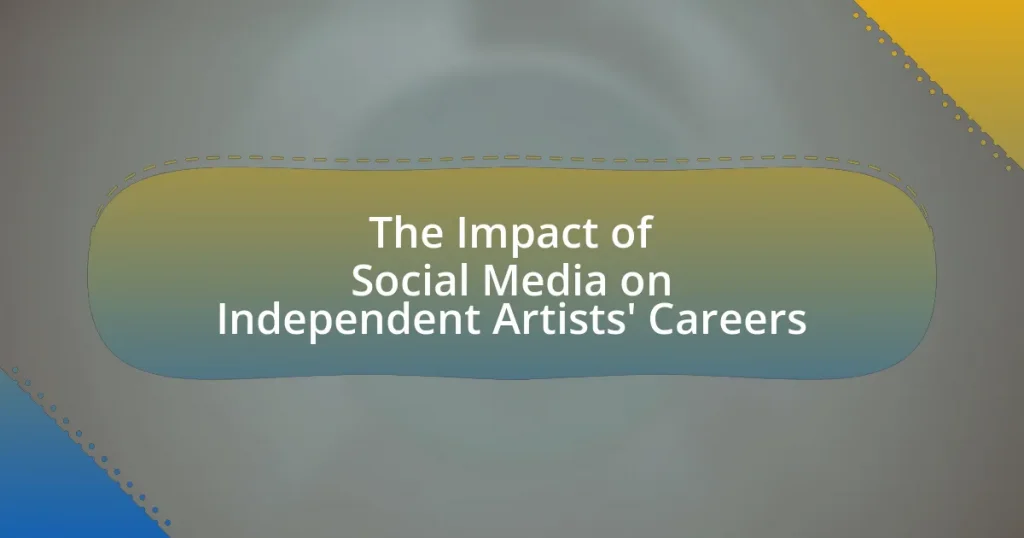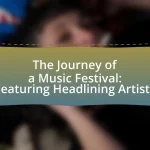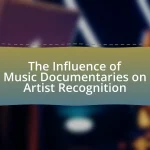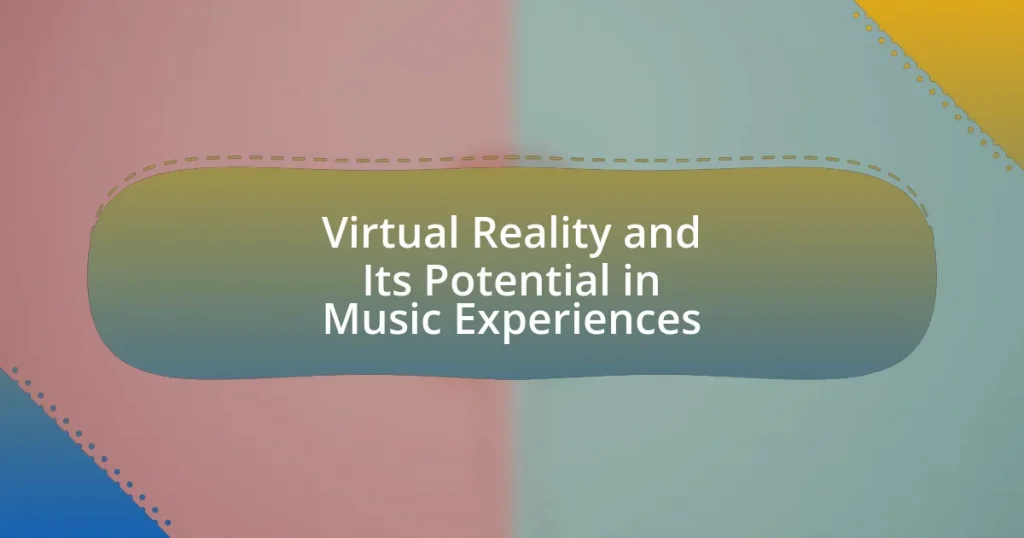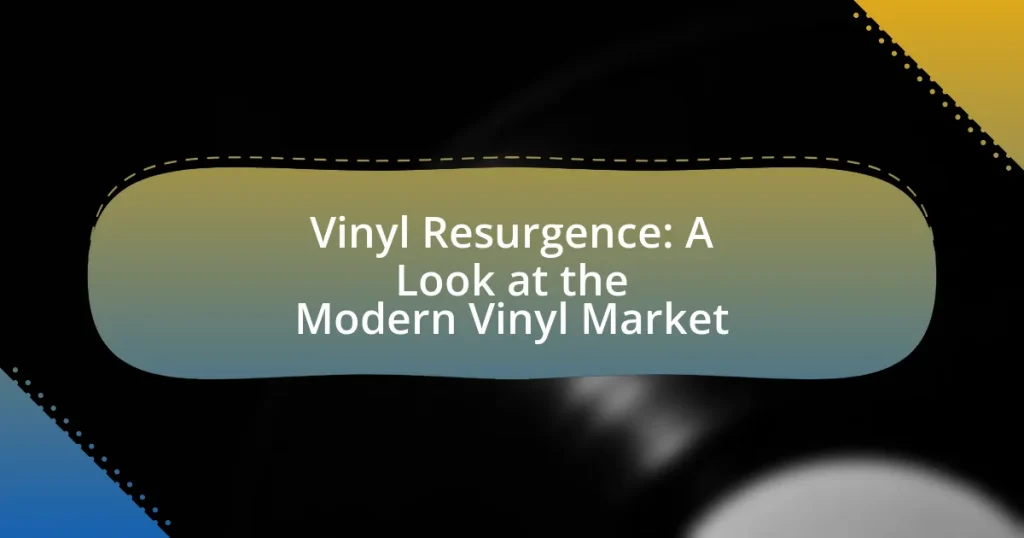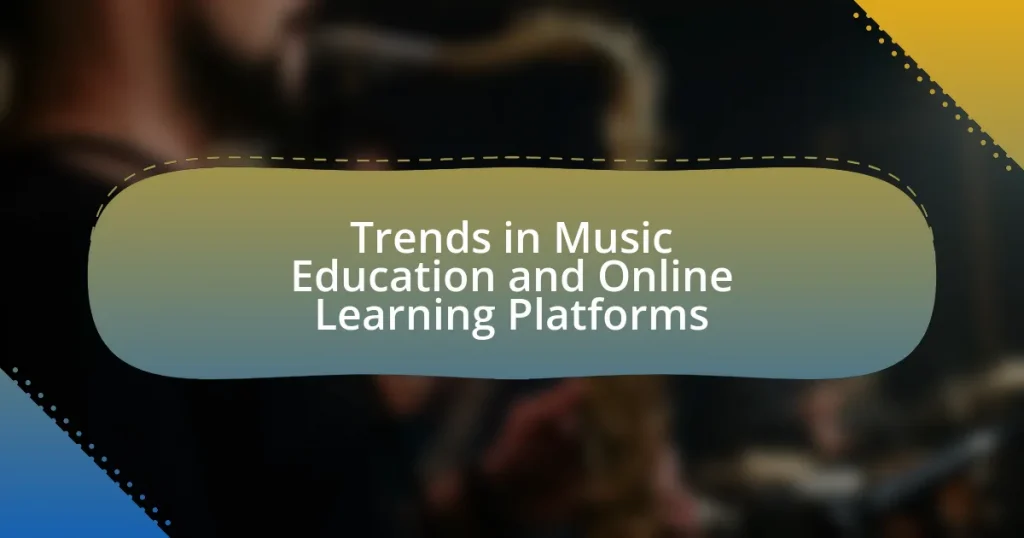The article examines the impact of social media on the careers of independent artists, highlighting how these platforms facilitate self-promotion, audience engagement, and brand building without the need for traditional record labels. It discusses the transformative role of social media in democratizing the music industry, enabling artists to reach global audiences and connect with industry professionals. Key platforms such as Spotify, Instagram, and Bandcamp are identified for their influence on visibility and revenue generation. The article also addresses the challenges independent artists face, including algorithm changes and content oversaturation, while providing strategies for effective social media utilization to enhance career growth.
What is the Impact of Social Media on Independent Artists’ Careers?
Social media significantly enhances independent artists’ careers by providing them with platforms for self-promotion and audience engagement. Independent artists can reach global audiences without the need for traditional record labels, allowing them to share their work directly with fans. For instance, a study by the University of Southern California found that 70% of independent musicians use social media to promote their music, leading to increased visibility and fan interaction. Additionally, social media enables artists to build personal brands and connect with industry professionals, which can lead to collaborations and performance opportunities. This direct access to audiences and industry networks demonstrates the transformative impact of social media on the careers of independent artists.
How has social media changed the landscape for independent artists?
Social media has transformed the landscape for independent artists by providing them with direct access to audiences and enabling self-promotion without traditional gatekeepers. This shift allows artists to share their work widely, engage with fans, and build a personal brand, which was previously difficult without major label support. For instance, platforms like Instagram and TikTok have led to viral success stories, where artists gain significant followings and opportunities through organic reach. According to a 2021 report by the Music Industry Research Association, 70% of independent musicians credit social media as a crucial tool for their career growth, highlighting its role in democratizing the music industry and allowing for diverse voices to emerge.
What platforms are most influential for independent artists?
The most influential platforms for independent artists are Spotify, Instagram, and Bandcamp. Spotify provides a vast audience reach and streaming revenue opportunities, with over 365 million users, making it a key platform for music discovery. Instagram serves as a visual marketing tool, allowing artists to engage with fans and showcase their work, with over 1 billion active users facilitating direct interaction. Bandcamp empowers artists by allowing them to sell music directly to fans, retaining a larger share of revenue compared to traditional distribution methods. These platforms collectively enhance visibility, engagement, and revenue for independent artists.
How do different social media platforms cater to various artistic genres?
Different social media platforms cater to various artistic genres by providing tailored features and audiences that enhance the visibility and engagement of specific art forms. For instance, Instagram is highly visual, making it ideal for visual artists, photographers, and designers to showcase their work through images and short videos, leveraging features like Stories and Reels to reach wider audiences. TikTok, with its focus on short-form video content, supports musicians and performers by allowing them to share snippets of their work, often leading to viral trends that can significantly boost their careers. Facebook serves as a community-building platform, where artists from diverse genres can create groups, share events, and engage with fans in a more personal manner. Additionally, platforms like SoundCloud and Bandcamp specifically cater to musicians, providing tools for sharing and monetizing their music directly with listeners. These platform-specific features and user demographics enable artists to effectively connect with their target audiences, thereby enhancing their career opportunities.
What are the primary benefits of social media for independent artists?
The primary benefits of social media for independent artists include increased visibility, direct audience engagement, and cost-effective marketing. Social media platforms allow artists to showcase their work to a global audience, significantly expanding their reach beyond traditional galleries or local venues. For instance, a study by the Pew Research Center found that 69% of adults in the U.S. use social media, providing artists with a vast potential audience. Additionally, social media enables artists to interact directly with fans, fostering a community and building loyalty, which can lead to increased sales and support. Furthermore, marketing on social media is often more affordable than traditional advertising methods, allowing independent artists to promote their work without substantial financial investment.
How does social media enhance visibility for independent artists?
Social media enhances visibility for independent artists by providing a platform for direct engagement with audiences and promoting their work to a global audience. Through platforms like Instagram, Facebook, and TikTok, artists can share their music, artwork, or performances, reaching potential fans without the need for traditional media gatekeepers. For instance, a study by the Pew Research Center found that 72% of adults use social media, which allows independent artists to tap into a vast pool of potential listeners and buyers. Additionally, social media algorithms often favor engaging content, enabling artists to gain organic reach and visibility through shares and interactions, further amplifying their presence in the digital space.
In what ways does social media facilitate audience engagement?
Social media facilitates audience engagement by providing platforms for direct interaction, content sharing, and community building. These platforms enable independent artists to connect with their audience in real-time, fostering a sense of belonging and loyalty. For instance, artists can use features like live streaming, polls, and Q&A sessions to engage followers actively, which enhances their visibility and encourages participation. According to a study by the Pew Research Center, 69% of adults in the U.S. use social media, indicating a vast audience that artists can reach and engage with effectively. Additionally, user-generated content, such as comments and shares, amplifies an artist’s reach and creates a participatory culture, further solidifying audience engagement.
What challenges do independent artists face on social media?
Independent artists face several challenges on social media, including algorithm changes, oversaturation of content, and limited resources for marketing. Algorithm changes on platforms like Instagram and Facebook can significantly reduce the visibility of an artist’s posts, making it difficult for them to reach their audience. The oversaturation of content means that independent artists must compete with a vast number of creators, which can dilute their unique voice and make it harder to stand out. Additionally, many independent artists lack the financial resources and marketing expertise to effectively promote their work, limiting their ability to engage with potential fans and grow their following. These challenges collectively hinder the ability of independent artists to build a sustainable career through social media platforms.
How does algorithm change affect independent artists’ reach?
Algorithm changes significantly affect independent artists’ reach by altering how their content is distributed and discovered on social media platforms. For instance, when platforms like Instagram or TikTok modify their algorithms to prioritize certain types of content, independent artists may experience a decrease in visibility if their content does not align with the new criteria. A study by the Pew Research Center found that algorithm changes can lead to a 50% drop in engagement for creators who do not adapt quickly to new trends. This shift can limit their audience growth and reduce opportunities for monetization, ultimately impacting their overall career trajectory.
What are the risks of relying solely on social media for promotion?
Relying solely on social media for promotion poses significant risks, including limited audience reach, platform dependency, and potential negative public perception. Limited audience reach occurs because not all target demographics engage with social media, which can restrict exposure to a broader audience. Platform dependency arises as changes in algorithms or policies can drastically affect visibility and engagement, leading to unpredictable promotional outcomes. Additionally, potential negative public perception can result from over-saturation or perceived inauthenticity, which may alienate followers. According to a 2021 survey by the Pew Research Center, 69% of U.S. adults use social media, indicating that while it is popular, a substantial portion of the population remains unreachable through these channels alone.
How can independent artists effectively utilize social media?
Independent artists can effectively utilize social media by creating engaging content that showcases their work and connects with their audience. This involves regularly posting high-quality images, videos, and behind-the-scenes content that reflects their artistic process and personality. According to a study by the Pew Research Center, 69% of adults in the U.S. use social media, making it a vital platform for reaching potential fans and collaborators. Additionally, artists should engage with their followers through comments and direct messages, fostering a sense of community and loyalty. Utilizing targeted advertising on platforms like Instagram and Facebook can also help artists reach specific demographics, increasing their visibility and potential fan base.
What strategies can artists implement to grow their following?
Artists can grow their following by consistently engaging with their audience on social media platforms. Regularly posting high-quality content, such as behind-the-scenes footage, live performances, and personal stories, fosters a connection with followers. According to a study by the Pew Research Center, 72% of adults use social media, making it a vital tool for artists to reach potential fans. Additionally, collaborating with other artists and influencers can expand their reach, as partnerships often introduce artists to new audiences. Utilizing targeted hashtags and participating in trending challenges can also increase visibility, as posts that align with popular topics are more likely to be shared.
How can artists measure the success of their social media efforts?
Artists can measure the success of their social media efforts through key performance indicators (KPIs) such as engagement rates, follower growth, and conversion metrics. Engagement rates, which include likes, shares, and comments, indicate how well the audience interacts with the content, while follower growth reflects the expanding reach and popularity of the artist. Conversion metrics, such as website visits or sales generated from social media links, provide concrete evidence of the effectiveness of social media in driving actions that benefit the artist’s career. According to a study by Hootsuite, posts with higher engagement rates can lead to a 20% increase in follower growth, demonstrating the correlation between engagement and overall success on social media platforms.
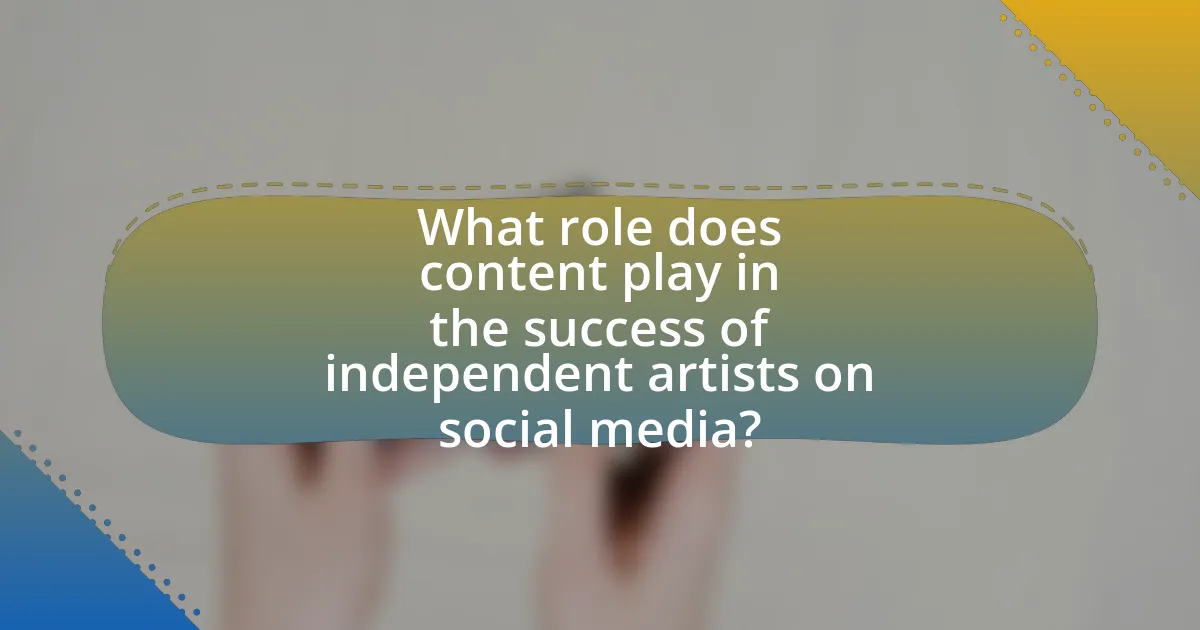
What role does content play in the success of independent artists on social media?
Content is crucial for the success of independent artists on social media as it directly influences audience engagement and visibility. High-quality, authentic content helps artists showcase their unique style, connect with fans, and build a loyal following. According to a study by the Pew Research Center, 72% of adults use social media, making it an essential platform for artists to reach potential listeners. Engaging content, such as music videos, behind-the-scenes footage, and personal stories, can lead to increased shares and interactions, amplifying an artist’s reach. Furthermore, consistent posting of relevant content can enhance an artist’s algorithmic favorability on platforms like Instagram and TikTok, resulting in greater exposure.
What types of content resonate most with audiences?
Engaging visual content, such as videos and images, resonates most with audiences. Research indicates that posts featuring visuals receive 94% more views than text-only content, highlighting the importance of visual storytelling in capturing attention. Additionally, emotionally driven narratives, including personal stories and behind-the-scenes glimpses, foster deeper connections, as 70% of consumers prefer brands that share relatable experiences. This data underscores the effectiveness of combining visual elements with authentic storytelling to engage audiences effectively.
How can visual content enhance an artist’s brand on social media?
Visual content can significantly enhance an artist’s brand on social media by increasing engagement and visibility. Research indicates that posts featuring images receive 650% higher engagement than text-only posts, demonstrating the power of visuals in capturing audience attention. Additionally, platforms like Instagram and Pinterest, which prioritize visual content, allow artists to showcase their work effectively, leading to a stronger brand identity. This visual storytelling helps artists connect emotionally with their audience, fostering loyalty and encouraging sharing, which further amplifies their reach.
What is the importance of storytelling in an artist’s social media posts?
Storytelling is crucial in an artist’s social media posts because it fosters emotional connections with the audience. By sharing personal narratives, experiences, and the creative process, artists can engage followers on a deeper level, making their work more relatable and memorable. Research indicates that posts incorporating storytelling elements receive 300% more engagement than those that do not, highlighting the effectiveness of this approach in capturing attention and building community. This emotional resonance not only enhances audience loyalty but also increases the likelihood of sharing, thereby expanding the artist’s reach and influence.
How can independent artists maintain authenticity on social media?
Independent artists can maintain authenticity on social media by consistently sharing their genuine experiences, thoughts, and creative processes. This approach fosters a real connection with their audience, as studies show that 70% of consumers prefer brands that are transparent and authentic. By engaging in open conversations, showcasing behind-the-scenes content, and expressing their unique perspectives, independent artists can build a loyal following that values their true selves over curated personas.
What are the best practices for sharing personal stories and experiences?
The best practices for sharing personal stories and experiences include being authentic, concise, and engaging. Authenticity fosters trust and connection with the audience, as studies show that genuine storytelling can increase relatability and emotional engagement. Conciseness ensures that the message is clear and retains the audience’s attention; research indicates that shorter narratives are often more impactful. Engaging storytelling techniques, such as using vivid imagery and emotional resonance, can enhance the effectiveness of the message. Additionally, considering the platform’s audience and tailoring the content accordingly can maximize reach and impact, as demonstrated by successful independent artists who effectively leverage social media to share their journeys.
How can artists balance professionalism with personal expression?
Artists can balance professionalism with personal expression by establishing clear boundaries between their artistic identity and their professional obligations. This involves creating a distinct brand that reflects their personal style while adhering to industry standards and expectations. For instance, artists can maintain a consistent visual and thematic approach in their work that resonates with their audience, while also engaging in professional practices such as networking, marketing, and collaboration. Research indicates that artists who effectively manage their online presence on platforms like Instagram and TikTok can showcase their unique voice while attracting potential clients and collaborators, thus achieving a harmonious blend of personal expression and professionalism.
What are the emerging trends in social media for independent artists?
Emerging trends in social media for independent artists include the rise of short-form video content, increased use of live streaming, and the growing importance of niche platforms. Short-form video content, particularly on platforms like TikTok and Instagram Reels, allows artists to showcase their work creatively and engage with audiences quickly, leading to higher visibility and potential virality. Live streaming has become a vital tool for artists to connect with fans in real-time, offering performances, Q&A sessions, and behind-the-scenes content, which fosters a deeper connection with their audience. Additionally, niche platforms such as Bandcamp and SoundCloud are gaining traction, enabling artists to reach specific audiences and monetize their work more effectively. These trends reflect a shift towards more interactive and personalized engagement strategies that independent artists can leverage to enhance their careers.
How is live streaming impacting artist-audience relationships?
Live streaming is significantly enhancing artist-audience relationships by fostering real-time interaction and engagement. This immediacy allows artists to connect with their fans on a personal level, creating a sense of community and belonging. For instance, platforms like Twitch and Instagram Live enable artists to respond to audience comments and questions during performances, which can lead to increased loyalty and support from fans. According to a 2021 report by the International Federation of the Phonographic Industry, 70% of surveyed artists noted that live streaming helped them build stronger connections with their audience compared to traditional media. This shift in engagement dynamics illustrates how live streaming is reshaping the way artists and their audiences interact, making relationships more direct and personal.
What role do collaborations play in expanding reach on social media?
Collaborations significantly enhance reach on social media by leveraging the combined audiences of the involved parties. When independent artists collaborate, they tap into each other’s follower bases, which can lead to increased visibility and engagement. For instance, a study by the Pew Research Center found that 70% of social media users are more likely to follow an account that features content from a creator they already admire. This indicates that collaborations can effectively introduce artists to new potential fans, thereby expanding their overall reach.
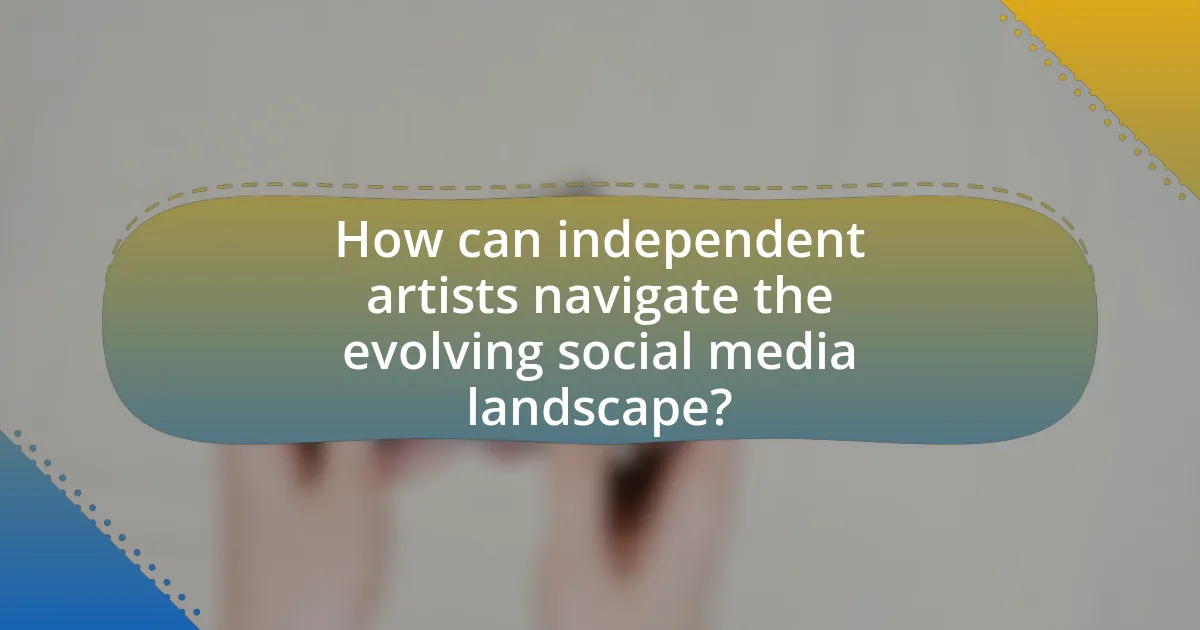
How can independent artists navigate the evolving social media landscape?
Independent artists can navigate the evolving social media landscape by strategically utilizing multiple platforms to engage with their audience and showcase their work. By diversifying their presence across platforms like Instagram, TikTok, and YouTube, artists can reach different demographics and maximize their visibility. For instance, Instagram’s visual focus allows artists to share images and videos of their art, while TikTok’s short-form video format can be used for creative storytelling and behind-the-scenes content.
Moreover, leveraging analytics tools provided by these platforms enables artists to understand their audience better and tailor their content accordingly. According to a 2021 survey by the Pew Research Center, 69% of U.S. adults use social media, highlighting its significance as a tool for outreach and connection. Engaging with followers through comments, live sessions, and collaborations can also foster a sense of community and loyalty, which is crucial for independent artists aiming to build a sustainable career.
What tools and resources are available for artists to enhance their social media presence?
Artists can enhance their social media presence using tools like Canva for graphic design, Hootsuite for social media management, and Buffer for scheduling posts. Canva allows artists to create visually appealing content easily, which is crucial for platforms like Instagram and Facebook where visuals dominate. Hootsuite and Buffer enable artists to manage multiple social media accounts from one dashboard, schedule posts for optimal engagement times, and analyze performance metrics to refine their strategies. According to a 2021 survey by the Pew Research Center, 69% of adults in the U.S. use social media, highlighting the importance of these tools for reaching a broad audience.
How can analytics tools help artists refine their social media strategies?
Analytics tools can help artists refine their social media strategies by providing data-driven insights into audience engagement and content performance. These tools track metrics such as likes, shares, comments, and follower growth, allowing artists to identify which types of content resonate most with their audience. For instance, a study by Hootsuite found that posts with videos receive 48% more engagement than those without, highlighting the importance of content type in strategy refinement. By analyzing this data, artists can adjust their posting frequency, content style, and engagement tactics to better align with audience preferences, ultimately enhancing their online presence and career growth.
What role do social media management platforms play in an artist’s workflow?
Social media management platforms streamline an artist’s workflow by centralizing content scheduling, audience engagement, and performance analytics. These platforms enable artists to plan and automate posts across multiple social media channels, saving time and ensuring consistent online presence. For instance, tools like Hootsuite and Buffer allow artists to analyze engagement metrics, helping them refine their strategies based on audience interactions. According to a study by the Pew Research Center, 72% of adults use social media, highlighting its significance in reaching potential fans and promoting work effectively.
What are the best practices for independent artists on social media?
Independent artists should consistently engage with their audience, post high-quality content, and utilize analytics to optimize their social media strategy. Engaging with followers through comments, live sessions, and direct messages fosters community and loyalty, which is crucial for building a fan base. Posting high-quality visuals and videos of their work showcases their talent effectively, as studies show that posts with images receive 94% more views than text-only posts. Utilizing analytics tools helps artists understand what content resonates with their audience, allowing them to refine their approach and increase engagement. These practices are supported by research indicating that active engagement and quality content significantly enhance visibility and growth on social media platforms.
How can artists create a consistent posting schedule?
Artists can create a consistent posting schedule by establishing a content calendar that outlines specific dates and times for posts. This method allows artists to plan their content in advance, ensuring regular engagement with their audience. Research indicates that brands and individuals who post consistently see a 50% increase in audience engagement, highlighting the importance of regularity in social media presence. By utilizing tools like scheduling software, artists can automate their posts, further maintaining consistency without the need for daily manual updates.
What tips can artists follow to engage with their audience effectively?
Artists can engage with their audience effectively by utilizing social media platforms to share authentic content and interact directly with fans. Regularly posting behind-the-scenes content, personal stories, and engaging visuals fosters a sense of connection and transparency. Research indicates that 70% of consumers feel more connected to brands when the CEO is active on social media, highlighting the importance of personal engagement. Additionally, responding to comments and messages promptly can enhance audience loyalty, as studies show that timely interactions increase customer satisfaction and retention.
What common pitfalls should independent artists avoid on social media?
Independent artists should avoid oversharing personal content on social media, as it can dilute their professional image and alienate potential fans. Maintaining a clear boundary between personal and professional posts helps to establish a brand identity that resonates with audiences. Additionally, artists should refrain from engaging in negative interactions or controversies, as this can lead to a damaged reputation and loss of followers. Consistency in posting is also crucial; irregular updates can cause audiences to lose interest. Lastly, neglecting audience engagement, such as failing to respond to comments or messages, can hinder relationship-building with fans, which is essential for career growth.
How can artists prevent burnout from social media engagement?
Artists can prevent burnout from social media engagement by setting clear boundaries around their online activity. Establishing specific times for social media use helps manage exposure and reduces feelings of obligation to constantly engage. Research indicates that excessive social media use can lead to increased stress and anxiety, which are key contributors to burnout. For instance, a study published in the Journal of Social and Clinical Psychology found that limiting social media use to 30 minutes a day significantly improved well-being among participants. By prioritizing mental health and creating a balanced approach to social media, artists can maintain their creativity and passion without succumbing to burnout.
What mistakes can undermine an artist’s credibility online?
Mistakes that can undermine an artist’s credibility online include inconsistent branding, poor engagement with followers, and sharing low-quality content. Inconsistent branding confuses audiences and dilutes the artist’s identity, making it difficult for fans to connect. Poor engagement, such as ignoring comments or failing to respond to messages, can lead to a perception of arrogance or disinterest, alienating potential supporters. Sharing low-quality content, whether in terms of visuals or audio, can damage an artist’s reputation, as audiences often judge professionalism based on the quality of shared work. These factors collectively contribute to a diminished online presence and credibility, impacting an artist’s ability to build a loyal fan base.
